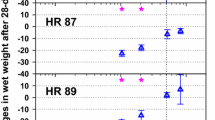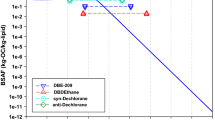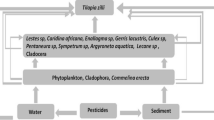Abstract
Freshwater sediment-dwelling Lumbriculus variegatus is known to serve as a vector for the transfer of contaminants from sediments to higher trophic level organisms, but limited data exist on the bioaccumulation of chemicals associated with sediments containing high total organic carbon (TOC). In the current study, sediments from the north shore area of Lake Apopka (Florida, USA), containing very high TOC [39 % (w/w)], were spiked with four chemicals—p,p′-dichlorordiphenyldichloroethylene (p,p′-DDE), dieldrin, fipronil, and triclosan—individually or in a mixture of the four and then used for bioaccumulation studies. Tissue concentrations of chemicals in L. variegatus were measured at 2, 7, 14, 21, and 28 days of exposure, and the bioaccumulation potential was evaluated using biosediment accumulation factors [BSAF (goc/glipid)]. Increase in total body burdens of all four chemicals in L. variegatus was rapid at day 2 and reached a steady-state level after 7 days in both single and mixture experiments. Tissue concentrations of fipronil peaked after 2 days and then decreased by 70 % in sediment experiments suggesting that in addition to the degradation of fipronil that occurred in the sediment, L. variegatus may also be able to metabolize fipronil. The calculated 28-day BSAF values varied among the chemicals and increased in the order fipronil (1.1) < triclosan (1.4) < dieldrin (21.8) < p,p′-DDE (49.8) in correspondence with the increasing degree of their hydrophobicity. The relatively high BSAF values for p,p′-DDE and dieldrin probably resulted from lower-than-expected sorption of chemicals to sediment organic matter either due to the nature of the plant-derived organic matter, as a result of the relatively short equilibration time among the various compartments, or due to ingestion of sediment particles by the worms.


Similar content being viewed by others
References
Aranami K, Readman JW (2007) Photolytic degradation of triclosan in freshwater and seawater. Chemosphere 66:1052–1056
Baird S, Garrison A, Jones J, Avants J, Bringolf R, Black M (2013) Enantioselective toxicity and bioaccumulation of fipronil in fathead minnows (Pimephales promelas) following water and sediment exposures. Environ Toxicol Chem 32:222–227
Belden JB, Ownby DR, Lotufo GR, Lydy MJ (2005) Accumulation of trinitrotoluene (TNT) in aquatic organisms: part 2—Bioconcentration in aquatic invertebrates and potential for trophic transfer to channel catfish (Ictalurus punctatus). Chemosphere 58:1161–1168
Bobé A, Cooper J, Coste CM, Muller M (1998) Behaviour of fipronil in soil under Sahelian Plain field conditions. Pestic Sci 52:275–281
Buth JM, Steen PO, Sueper C, Blumentritt D, Vikesland PJ, Arnold WA et al (2010) Dioxin photoproducts of triclosan and its chlorinated derivatives in sediment cores. Environ Sci Technol 44:4545–4551
Chalew TE, Halden RU (2009) Environmental exposure of aquatic and terrestrial biota to triclosan and triclocarban. J Am Water Works Assoc 45:4–13
Cornelissen G, Gustafsson Ö, Bucheli TD, Jonker MT, Koelmans AA, van Noort PC (2005) Extensive sorption of organic compounds to black carbon, coal, and kerogen in sediments and soils: mechanisms and consequences for distribution, bioaccumulation, and biodegradation. Environ Sci Technol 39:6881–6895
Crawford JK, Luoma SN (1993) Guidelines for studies of contaminants in biological tissues for the national water-quality assessment programs. Open-File Report 92-494. U.S. Geological Survery, Lemoyne, PA
DeLorenzo M, Keller J, Arthur C, Finnegan M, Harper H, Winder V et al (2008) Toxicity of the antimicrobial compound triclosan and formation of the metabolite methyl-triclosan in estuarine systems. Environ Toxicol 23:224–232
Di Toro DM, Zarba CS, Hansen DJ, Berry WJ, Swartz RC, Cowan CE et al (1991) Technical basis for establishing sediment quality criteria for nonionic organic chemicals using equilibrium partitioning. Environ Toxicol Chem 10:1541–1583
Ela WP, Sedlak DL, Barlaz MA, Henry HF, Muir DC, Swackhamer DL et al (2011) Toward identifying the next generation of superfund and hazardous waste site contaminants. Environ Health Perspect 119:6–10
Foster GD, Baksi SM, Means JC (1987) Bioaccumulation of trace organic contaminants from sediments by Baltic clams (Macoma balthica) and soft-shell clams (Mya arenaria). Environ Toxicol Chem 6:969–976
Ghosh U, Zimmerman JR, Luthy RG (2003) PCB and PAH speciation among particle types in contaminated harbor sediments and effects on PAH bioavailability. Environ Sci Technol 37:2209–2217
Gustafsson Ö, Haghseta F, Chan C, MacFarlane J, Gschwend PM (1996) Quantification of the dilute sedimentary soot phase: implications for PAH speciation and bioavailability. Environ Sci Technol 31:203–209
Hainzl D, Casida JE (1996) Fipronil insecticide: novel photochemical desulfinylation with retention of neurotoxicity. Proc Natl Acad Sci USA 93:12764–12767
Halden RU (2014) On the need and speed of regulating triclosan and triclocarban in the United States. Environ Sci Technol 48:3603–3611
Higgins CP, Paesani ZJ, Chalew TEA, Halden RU (2009) Bioaccumulation of triclocarban in Lumbriculus variegatus. Environ Toxicol Chem 28:2580–2586
Higgins CP, Paesani ZJ, Abbott Chalew TE, Halden RU, Hundal LS (2011) Persistence of triclocarban and triclosan in soils after land application of biosolids and bioaccumulation in Eisenia foetida. Environ Toxicol Chem 30:556–563
Karlsson MV, Marshall S, Gouin T, Boxall A (2015) Routes of uptake of diclofenac, fluoxetine, and triclosan into sediment‐dwelling worms. Environ Toxicol Chem
Konwick BJ, Garrison AW, Black MC, Avants JK, Fisk AT (2006) Bioaccumulation, biotransformation, and metabolite formation of fipronil and chiral legacy pesticides in rainbow trout. Environ Sci Technol 40:2930–2936
Kukkonen JV, Landrum PF, Mitra S, Gossiaux DC, Gunnarsson J, Weston D (2004) The role of desorption for describing the bioavailability of select polycyclic aromatic hydrocarbon and polychlorinated biphenyl congeners for seven laboratory-spiked sediments. Environ Toxicol Chem 23:1842–1851
Landrum PF, Faust WR (1991) Effect of variation in sediment composition on the uptake rate coefficient for selected PCB and PAH congeners by the amphipod, Diporeia sp. Aquatic toxicology and risk assessment, vol 14. American Society for Testing and Materials, Philadelphia, pp 263–279
Landrum PF, Eadie BJ, Faust WR (1992) Variation in the bioavailability of polycyclic aromatic hydrocarbons to the amphipod Diporeia (spp.) with sediment aging. Environ Toxicol Chem 11:1197–1208
Leppänen MT, Kukkonen JV (2000) Fate of sediment-associated pyrene and benzo[a]pyrene in the freshwater oligochaete Lumbriculus variegatus (Müller). Aquat Toxicol 49:199–212
Lin K, Haver D, Oki L, Gan J (2008) Transformation and sorption of fipronil in urban stream sediments. J Agric Food Chem 56:8594–8600
Lyytikäinen M, Pehkonen S, Akkanen J, Leppänen M, Kukkonen JV (2007) Bioaccumulation and biotransformation of polycyclic aromatic hydrocarbons during sediment tests with oligochaetes (Lumbriculus variegatus). Environ Toxicol Chem 26:2660–2666
Macherius A, Lapen DR, Reemtsma T, Römbke J, Topp E, Coors A (2014) Triclocarban, triclosan and its transformation product methyl triclosan in native earthworm species four years after a commercial-scale biosolids application. Sci Total Environ 472:235–238
MACTEC (2005) Lake Apopka north shore restoration area feasibility study, Orange and Lake Counties, FL. Final report project no. 609604004 for the St. John River Water Management District, Florida
Mehler WT, Li H, Pang J, Sun B, Lydy MJ, You J (2011) Bioavailability of hydrophobic organic contaminants in sediment with different particle-size distributions. Arch Environ Contam Toxicol 61:74–82
Miller TR, Heidler J, Chillrud SN, DeLaquil A, Ritchie JC, Mihalic JN et al (2008) Fate of triclosan and evidence for reductive dechlorination of triclocarban in estuarine sediments. Environ Sci Technol 42:4570–4576
Morrison HA, Gobas FAPC, Lazar R, Haffner GD (1996) Development and verification of a bioaccumulation model for organic contaminants in benthic invertebrates. Environ Sci Technol 30:3377–3384
Nelson DW, Sommers LE (1996) Total carbon, organic carbon, and organic matter. In: Sparks DL et al (eds) Methods of soil analysis, Part 3—Chemical Methods, vol 5., SSSA Book SeriesSoil Science Society of America, Inc, Madison, pp 961–1010
Qu H, Wang P, Ma R, Qiu X, Xu P, Zhou Z et al (2014) Enantioselective toxicity, bioaccumulation and degradation of the chiral insecticide fipronil in earthworms (Eisenia feotida). Sci Total Environ 485:415–420
Ramesh A, Balasubramanian M (1999) Kinetics and hydrolysis of fenamiphos, fipronil, and trifluralin in aqueous buffer solutions. J Agric Food Chem 47:3367–3371
Saint Johns River Water Management District (SJRWMD) (2006) March) Analysis of risks to piscivorous birds from pesticide residues in soils and fish on the North Shore Restoration Area at Lake Apopka, vol 4. Environmental Sciences Division, St. Johns River Water Management District, Palatka
Schlenk D, Huggett D, Allgood J, Bennett E, Rimoldi J, Beeler A et al (2001) Toxicity of fipronil and its degradation products to Procambarus sp.: field and laboratory studies. Arch Environ Contam Toxicol 41:325–332
Singer H, Müller S, Tixier C, Pillonel L (2002) Triclosan: occurrence and fate of a widely used biocide in the aquatic environment: Field measurements in wastewater treatment plants, surface waters, and lake sediments. Environ Sci Technol 36:4998–5004
Snyder EH, O’Connor GA, McAvoy DC (2011) Toxicity and bioaccumulation of biosolids-borne triclocarban (TCC) in terrestrial organisms. Chemosphere 82:460–467
Standley LJ (1997) Effect of sedimentary organic matter composition on the partitioning and bioavailability of dieldrin to the oligochaete Lumbriculus variegatus. Environ Sci Technol 31:2577–2583
Tracey G, Hansen D (1996) Use of biota-sediment accumulation factors to assess similarity of nonionic organic chemical exposure to benthically-coupled organisms of differing trophic mode. Arch Environ Contam Toxicol 30:467–475
United States Environmental Protection Agency (1996) New pesticide Fact Sheet: EPA 737-F- 96-005. Office of prevention, Pesticides and Toxic Substances, Washington, DC
United States Environmental Protection Agency (2000) Methods for measuring the toxicity and bioaccumulation of sediment-associated contaminants with freshwater invertebrates, 2nd ed. EPA 600/R-9/064. Office of Research and Development, Mid-Continent Ecological Division, and Office of Water, Office of Science and Technology. USEPA, Duluth
Volner EC, Li YF (1995) Global usage of selected persistent organochlorines. Sci Total Environ 160(161):201–210
Walse SS, Pennington PL, Scott GI, Ferry JL (2004) The fate of fipronil in modular estuarine mesocosms. J Environ Monit 6:58–64
You J, Landrum PF, Lydy MJ (2006) Comparison of chemical approaches for assessing bioavailability of sediment-associated contaminants. Environ Sci Technol 40:6348–6353
You J, Brennan A, Lydy MJ (2009) Bioavailability and biotransformation of sediment-associated pyrethroid insecticides in Lumbriculus variegatus. Chemosphere 75:1477–1482
Acknowledgments
We thank Emily R. Pszczola for help with sample collection. This project was supported by the National Institute of Environmental Health Sciences (Award No. R01-ES020899).
Author information
Authors and Affiliations
Corresponding author
Rights and permissions
About this article
Cite this article
Dang, V.D., Kroll, K.J., Supowit, S.D. et al. Bioaccumulation of Legacy and Emerging Organochlorine Contaminants in Lumbriculus variegatus . Arch Environ Contam Toxicol 71, 60–69 (2016). https://doi.org/10.1007/s00244-016-0264-x
Received:
Accepted:
Published:
Issue Date:
DOI: https://doi.org/10.1007/s00244-016-0264-x




